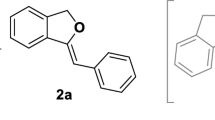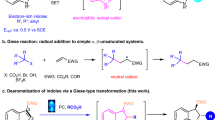Abstract
We report a single bifunctional ruthenium catalyst for cyclization of terminal alkynylaryl amines and -phenols to corresponding indole and benzofuran derivatives in good yields. Key features the ability to cyclize and hydrate terminal alkynes in one step and to deuterate the heteroaromatic compounds formed.
Similar content being viewed by others
Avoid common mistakes on your manuscript.
1 Introduction
Terminal alkynes can be activated by isomerizing them on metal centers to form metal vinylidene complexes [1]. These are usually sufficiently electrophilic for nucleophilic attack by water [2], alcohol [3, 4], phenols [5], amines [6, 7] and many other nucleophiles. A wide variety of transition metal based catalysts have been reported to catalyze alkyne hydration [8], alkynylaryl amine [9–15] and -phenol [16–19] cyclization, etc. However, there has not been any report, to the best of our knowledge, of one catalyst capable of carrying out cyclization and hydration in the same reaction flask. Here we present our single bifunctional ruthenium catalyst which possesses a unique set of applications: cyclization, hydration and deuteration to synthesize a variety of functionalized heteroaromatic compounds.
Our group reported a bifunctional catalyst for terminal alkyne hydration [20] in 2004. During the study of the substrate scope it was found that sulfonamide protected alkynyl amine 2 cyclized to hemiaminal 3 (Scheme 1) which on further heating eliminated water to give enamine derivative 5. We have also reported mechanistic studies of alkyne hydration [21], which so far confirm the attack of water on the intermediate vinylidene. Therefore, we envisioned that our catalyst could generate an intermediate aldehyde which in the presence of a tethered amine or phenol, could lead to cyclization. N and O heterocycle synthesis would then be easily possible via dehydration. Our initial attempts to perform cycloisomerization reactions of homopropargylic alcohols [22] led to the conclusion that our ruthenium phosphine complexes formed carbene complexes which did not readily turn over to give required enol ethers as products. We then focused on the reactions of o-alkynylaryl amines and -phenols with a variety of functional groups on the nitrogen atom as well as the aromatic ring to give different substituted indole and benzofuran derivatives, as shown in Table 1 [23]. Eventually we realized that the catalyst has two potential applications—(1) anti-Markovnikov alkyne hydration and (2) terminal alkyne cyclization to give heteroaromatic compounds. The studies of our catalyst on bis alkyne substrates and the ability to deuterate is presented.
2 Experimental
Example of procedure for one-pot cyclization and hydration—synthesis and isolation of 18 (Scheme 2): To a scintillation vial containing a stir bar was added 12 (0.0350 g, 0.224 mmol), 1 (0.0111 g, 0.011 mmol), H2O (0.0206 g, 1.121 mmol) and acetone (3.0 mL). The cap was then closed and the vial was heated at 70 °C for 10 h. After confirming the completion of the reaction by TLC the solvents were evaporated by rotary evaporation. The residue was extracted with pentane and the solvent was once again evaporated to give 18 as a pale yellow solid (0.0280 g, 74%). 1H NMR (d8-THF, 400 MHz) δ 9.71 (t, J = 2.4 Hz, 1H), 7.70 (d, J = 2.4 Hz, 1H), 7.31 (s, 1H), 6.97 (s, 1H), 6.75 (d, J = 2.4 Hz, 1H), 3.85 (d, J = 2.0 Hz, 1H), 2.40 (s, 1H); 13C NMR (d8-THF, 100 MHz) 197.8, 153.4, 146.4, 133.4, 128.8, 127.6, 120.9, 117.1, 107.4, 45.1, 21.3; FT-IR (KBr, cm−1) 3111.8, 2922.9, 2831.9, 2360.7, 1719.6, 1538.4, 1470.9, 1206.6, 1137.2, 1032.6, 761.7, 730.6; HRMS calcd for C11H10O2: 174.0676, found: 174.0675. For anhydrous conditions the reaction was performed in dry and deoxygenated THF.
3 Results and Discussion
Scheme 2 summarizes the studies towards one pot cyclization and hydration studies. When 12 was subjected to catalytic conditions in d 8-THF it gave 15 (20 h, 57%) based on NMR integrations. It was also noted that the reaction was faster in d 6-acetone. However traces of the aldehyde 18 were also seen due to the trace amount of water present in d 6-acetone.
With this in mind the cyclization–hydration reaction was done in d 6-acetone and resulted in the formation of 18 (8 h, 94%). The success of these reactions led us to try other nitrogen analogues wherein cyclization of 13 under anhydrous conditions yielded 16 (20 h, 75%). Strangely though the subsequent hydration reaction was slow, giving after 24 h only 11% of 19, with much of 16 (55%) remaining. Our hypothesis for this can be understood from Scheme 3, where the indole NH must play a role; in putative intermediate F, hydrogen bonding of the pyridinium moiety to the acyl could be precluded by competitive interaction with the indole NH. Consistent with this, not only did N-methylated substrate 14 cyclize to indole derivative 17 (9 h, 79%), but also hydration (forming 20) was more facile, though 20 mol% catalyst was necessary. Also noted during the cyclization of substrate 14 was that the Cp peak for the catalyst was observed at 4.51 ppm in 1H NMR and the corresponding 31P signal for the same was at 43.5 ppm. During the course of the reaction the integral value of the Cp peak (1H NMR, 4.52 ppm) decreased whereas a new Cp peak was observed (1H NMR, 5.12 ppm and 31P, 43.7 ppm). This signal corresponded to a catalytically inactive species which has been observed in previous mechanistic studies of alkyne hydration.
Finally we focused our attention on synthesis of deuterated heterocycles (Scheme 4). Previous attempts to make deuterated indoles required the NH to be protected [24–26]. It has still been difficult to deuterate both 2 and 3 positions of these heterocycles, and in fact 2,3-d 2-benzofuran is unknown. Our studies showed that using D2O instead of H2O, allowed the incorporation of deuterium at the 2 and 3 positions in significantly high yields. For this, substrates 7 and 8 were subjected to alkyne hydration conditions in presence of D2O. Results showed that percent deuteration at each of the possible sites depended on the molar ratio of deuterium present in the reaction mixture, but in each case was 100% of the amount theoretically possible at each position. Control experiments were also performed on indole and benzofuran to study if there was any evidence of H/D exchange with D2O itself or in the presence of 1. For this indole and benzofuran were dissolved (in separate J. Young tubes) in d 6-acetone and 30 equivalents of D2O was added followed by heating (70 °C, 1 h) the J. Young tube and monitoring the reaction by 1H NMR. Subsequently, 1 (2 mol%) was added and the heating was continued over a period of 6 days. Under these conditions the NH hydrogen of indole was the only site susceptible to H/D exchange but there was no notable H/D exchange at positions 2 and 3 of either indole or benzofuran.
We have shown that the alkyne hydration catalyst is versatile in its synthetic application. Not only is it applicable in the synthesis of aldehydes but also in one pot cyclization and hydration yielding an aldehyde at position 7 of these heteroaromatic compounds. This has high synthetic utility as these aldehydes can lead to isoprene units which are known to exist in a variety of biologically active natural products. Also shown is the easy access to deuterated compounds with just a change of the nucleophile from H2O to D2O at otherwise not easy positions. Other synthetic applications of this catalyst in cyclization reactions are also in process.
We would like to thank the NSF for financial support and Dr. LeRoy Lafferty for all the help in NMR experiments.
References
Trost BM, McClory A (2008) Chem Asian J 3:164 (and references therein)
Ogo S, Uehara K, Abura T, Watanabe Y, Fukuzumi S (2004) J Am Chem Soc 126:16520
Gabriele B, Salerno G, Fazio A, Pittelli R (2003) Tetrahedron 59:6251
Kadota I, Lutete LM, Shibuya A, Yamamoto Y (2001) Tetrahedron Lett 42:6207
Nan Y, Miao H, Yang Z (2000) Org Lett 2:297
Sakai N, Annaka K, Konakahara T (2004) Org Lett 6:1527
Zhang H, Ye H, Moretto AF, Burmfield KK, Maryanoff BE (2000) Org Lett 2:89
Hintermann L, Labonne A (2007) Synthesis 8:1121 (and references therein)
Murai K, Hayashi S, Takaychi N, Kita Y, Fujioka H (2009) J Org Chem 74:1418
Nakamura I, Sata Y, Konta S, Terada M (2009) Tetrahedron Lett 50:2075
Metha S, Waldo J, Larock RC (2009) J Org Chem 74:1141
McClory A, Trost B (2007) Angew Chem Int Ed 46:2074
Terrasson V, Michaux J, Gaucher A, Wehbe J, Marque S, Prim D, Campagne J (2007) Eur J Org Chem 5332
Tang S, Xie Y, Li J, Wang N (2007) Synthesis 12:1841
Yin Y, Ma W, Chai Z, Zhao G (2007) J Org Chem 72:5731
Isono N, Lautens M (2009) Org Lett 11:1329
Martinez C, Alvarez R, Aurrecochea JM (2009) Org Lett 11:1083
Li X, Chianese AR, Vogel T, Crabtree RH (2005) Org Lett 7:5437
Hu Y, Zhang Y, Yeng Z, Fathi R (2002) J Org Chem 67:2065
Grotjahn DB, Lev DA (2004) J Am Chem Soc 126:12232
Grotjahn DB, Kragulj EJ, Zeinalipour-Yazdi CD, Miranda-Soto V, Lev DA, Cooksy AL (2008) J Am Chem Soc 130:10860
Grotjahn DB, Nair RN (Unpublished results)
Nair RN, Lee PJ, Grotjahn DB (2010) Chem Eur J (in press)
Yao W-M, Gawrisch K (1999) J Label Compd Radiopharm 42:709
Anto S, Getvoldsen GS, Harding JR, Jones JR, Lu S-Y, Russel JC (2000) J Chem Soc, Perkin Trans 2:2208
Ibaceta-Lizana JSL, Jackson AH, Paristpan N, Shannon PVR (1987) J Chem Soc, Perkin Trans 2:1221
Open Access
This article is distributed under the terms of the Creative Commons Attribution Noncommercial License which permits any noncommercial use, distribution, and reproduction in any medium, provided the original author(s) and source are credited.
Author information
Authors and Affiliations
Corresponding author
Rights and permissions
Open Access This is an open access article distributed under the terms of the Creative Commons Attribution Noncommercial License (https://creativecommons.org/licenses/by-nc/2.0), which permits any noncommercial use, distribution, and reproduction in any medium, provided the original author(s) and source are credited.
About this article
Cite this article
Nair, R.N., Lee, P.J. & Grotjahn, D.B. One-Pot Formation of Functionalized Indole and Benzofuran Derivatives Using a Single Bifunctional Ruthenium Catalyst. Top Catal 53, 1045–1047 (2010). https://doi.org/10.1007/s11244-010-9529-1
Published:
Issue Date:
DOI: https://doi.org/10.1007/s11244-010-9529-1








